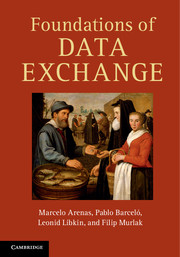Book contents
- Frontmatter
- Dedication
- Contents
- Preface
- Part One GETTING STARTED
- Part Two RELATIONAL DATA EXCHANGE
- Part Three XML DATA EXCHANGE
- 10 The problem of XML data exchange
- 11 Patterns and mappings
- 12 Building solutions
- 13 Answering tuple queries
- 14 XML-to-XML queries
- 15 XML data exchange via relations
- 16 Endnotes to Part Three
- Part Four METADATA MANAGEMENT
- References
- Index
13 - Answering tuple queries
from Part Three - XML DATA EXCHANGE
Published online by Cambridge University Press: 05 June 2014
- Frontmatter
- Dedication
- Contents
- Preface
- Part One GETTING STARTED
- Part Two RELATIONAL DATA EXCHANGE
- Part Three XML DATA EXCHANGE
- 10 The problem of XML data exchange
- 11 Patterns and mappings
- 12 Building solutions
- 13 Answering tuple queries
- 14 XML-to-XML queries
- 15 XML data exchange via relations
- 16 Endnotes to Part Three
- Part Four METADATA MANAGEMENT
- References
- Index
Summary
The ultimate goal of data exchange is to answer queries over the target data in a way consistent with the source data. In this chapter we focus on queries that return sets of tuples of data values. The reason for this restriction is twofold:
• first, for such queries the notion of certain answers is easy to define; and
• second, already for these queries we shall be able to identify features that need to be ruled out in order to ensure tractability of query answering.
We deal with a query language based on tree patterns, as it forms a natural analog of (unions of) conjunctive queries. We show that the problem of finding certain answers is in CONP, just like for conjunctive queries in the relational case. We then identify several features specific to XML, such as disjunction in DTDs or the horizontal order, that make the query answering problem intractable. Finally, we give a polynomial query answering algorithm that computes certain answers for unions of conjunctive queries that only use vertical navigation, restricted to schema mappings with nested-relational DTDs.
The query answering problem
Just like in the relational case, we study conjunctive queries and their unions. As we have learned, it is convenient to work with tree patterns, which have very similar expressivity to conjunctive queries. Thus, for querying XML documents we use the same language as for the dependencies: tree patterns with equalities and inequalities, to capture the analog of relational conjunctive queries (with inequalities).
- Type
- Chapter
- Information
- Foundations of Data Exchange , pp. 182 - 192Publisher: Cambridge University PressPrint publication year: 2014



